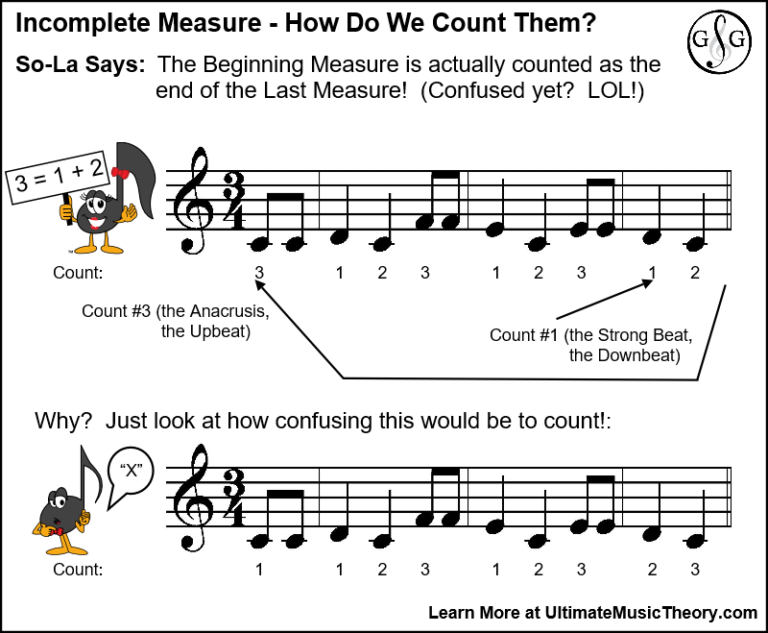

- #Lilypond anacrusis measure numbers how to
- #Lilypond anacrusis measure numbers pdf
- #Lilypond anacrusis measure numbers software
But my problems with this method are, that it isn't really right from a music theory perspective (it's not a bar of 1/4), and it's compromising my LilyPond code. want the bar number for the anacrusis to appear just right of the clef. You don't need to fiddle with the timing in any way. d4 \bar '.' and LilyPond will place the ending bar line wherever it currently happens to be within the measure. I feel that you were hoping for a script-oriented way of having LilyPond generate a rehearsal mark with the current measure number (like a circled 9 or 15) whenever you use the 'mark default' command.
#Lilypond anacrusis measure numbers pdf
This does work the code compiles, the pdf is accurate, and MuseScore can recognise the anacrusis. The partial bar at the end of a stanzaed piece with pickup, however, wants a double bar line (different from the default) anyway.

To get the pdf to look right, I also have to adjust their appearance of the time signature, and to set the first bar number to zero. (This makes the \partial command unnecessary.) I have to explicitly write a "bar" with a time signature that corresponds to the length of the anacrusis, and then set the real time signature for the first complete bar. To get MuseScore's "Recognise anacrusis" setting to work, I need to change the LilyPond code:
#Lilypond anacrusis measure numbers how to
I do know how to fix the anacrusis manually:

LilyPonds \partial command apparently isn't effecting the midi file in a way that MuseScore understands. Whether selected or not, MuseScore continues to render the score as if there isn't an anacrusis. Seems like it should be just what I need to get the anacrusis to render correctly, but it doesn't work. "Recognise anacrusis" / "Recognize pickup measure" Quantisation", etc.) can be adjusted, then clicking "Apply" will re-import the file. Several settings (such as "MuseScore instrument", "Max. Note that this is set to a negative number. Opening this file with MuseScore will render the score, and a "MIDI import panel" will also pop up. The property measurePosition contains a rational number indicating how much of the measure has passed at this point. When there is an anacrusis in the piece, I use LilyPond's \partial command: \version "2.21.0"Ĭompiling the code generates a midi file.
#Lilypond anacrusis measure numbers software
Python is a trademark of the Python Software Foundation.Īny other trademarks I mentioned without realising are trademarks of their respective holders.I generate midi files in LilyPond and import them into MuseScore for playback. If you have problems, try a different Lilypond versionĪll material © Silas S. LP: (block of code) :LP (each delimeter at start of its line) Jim: Thank you for your reply and the second way to accomplish the partial measure. Ties (like Lilypond's, if you don't want dashes)Įrhu fingering (applies to previous note) 11.3k 5 5 gold badges 66 66 silver badges 104 104 bronze badges. Prohibit page breaks until end of this movement In Lilypond, by default measure numbers are printed in each new line. L: here are the syl- la- bles (all on one line) Time signature with quaver anacrusis (8th-note pickup)

Semiquaver, quaver, crotchet (16/8/4th notes)ĭotted versions of the above (50% longer)ĭemisemiquaver, hemidemisemiquaver (32/64th notes) Text files are whitespace-separated and can contain: Run jianpu-ly ly-file (or jianpu-ly text-files > ly-file) measurePosition property, which is a rational number that indicates how much of the measure has passed. > When I number my own scores, the bars that get numbers are > 1) The first bar of every staff/system > 2) Every 10 bars Regardless of location > I can do these two things independently, but am having problems getting > them to work together.
His style of jianpu is different from that produced by my jianpu-ly (which also has a different input format). Kyle Baldwin(I would put their name here if I could find it.)Īdditionally, David Zhang of Beijing extended this idea into a tighter integration of jianpu with Lilypond, often called jianpu10a.ly, which provides a JianpuStaff that accepts normal Lilypond code and translates it (a bit like Lilypond's TabStaff). For Chinese users, someone has written a Chinese summary of jianpu-ly which looks right.


 0 kommentar(er)
0 kommentar(er)
